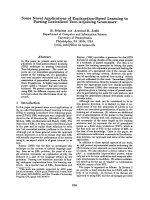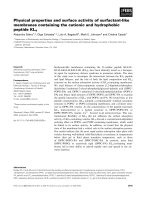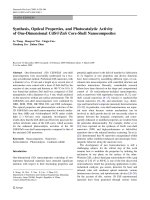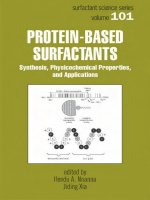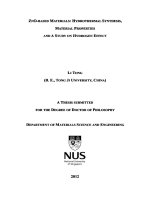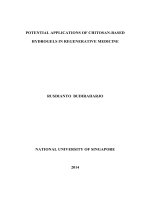Synthesis, physical properties and applications of bisanthene based near infrared dyes and semiconductors
Bạn đang xem bản rút gọn của tài liệu. Xem và tải ngay bản đầy đủ của tài liệu tại đây (3.03 MB, 143 trang )
SYNTHESIS, PHYSICAL PROPERTIES AND APPLICATIONS
OF BISANTHENE-BASED NEAR INFRARED DYES AND
SEMICONDUCTORS
LI JINLING
(B.Sc., SOOCHOW UNIVERSITY)
A THESIS SUBMITTED
FOR THE DEGREE OF DOCTOR OF PHILOSOPHY
DEPARTMENT OF CHEMISTRY
NATIONAL UNIVERSITY OF SINGAPORE
2011
I
ACKNOWLEGEMENTS
First of all, I wish to express my deep and sincere gratitude to my supervisor, Dr.
Jishan Wu, for his continuous professional guidance and inspiration, as well as
unreserved support throughout my Ph.D. study. His wide knowledge, constructive
criticisms and insightful comments have provided a fundamental and significant basis
for the present thesis. More importantly, his rigorous research methodology,
objectivity and enthusiasm in scientific discovery will deeply impact on my life and
future career. With sincere thanks, I want to thank Dr. Chunyan Chi for her constant
support and suggestion during the years and I gratefully appreciate her kind help and
concern.
I am deeply grateful to all the past/current labmates and collaborators in this group,
Dr. Xiaojie Zhang, Chongjun Jiao, Jingjing Chang, Dr. Kai Zhang, Dr. Jun Yin, Dr.
Jing Luo, Dr. Baomin Zhao, Dr. Weibin Cui, Suvankar Dasgupta, Zhe Sun, Lijun Zhu,
Wangdong Zeng, Dr. Xiaobo Huang, Dr. Ding Luo, Hemi Qu, Jinjun Shao, Chenhua
Tong, Lu Mao, Qun Ye, Tianyu Lang, Yong Ni, Gaole Dai. Without their help and
encouragements, this work could not have been completed on time.
I would like to express my thanks to National University of Singapore for the supply
of the research scholarship.
Finally, I would like to express my loving thanks to my parents, my elder brother, my
sister in-law, and my lovely nieces and nephew. Their love and encouragement
ignited my passion for the accomplishment documented in this thesis.
II
TABLE OF CONTENTS
ACKNOWLEGEMENTS……………………… ………………………………… I
TABLE OF CONTENTS……………… ………………………………………… II
SUMMARY…………………………… …………………………………….…….VI
LIST OF TABLES…………………………… ……………………… ………….IX
LIST OF FIGURES…………………………………… …………………… ……X
LIST OF SCHEMES…………………………………………… ………………XV
CHAPTER 1:
Introduction…………………… ………………………… ……………………….1
1.1 Polycyclic Aromatic Hydrocarbons……………………………… …………… 1
1.2 Overview on the Development of Bisanthene……………… ……… ………….4
1.3 Objectives……………………………………… ……………………………….17
References……………………………………………………………………………19
CHAPTER 2: Meso-substituted Bisanthenes as Soluble and Stable NIR
Dyes………… …………………………………………………………………… 23
2.1 Introduction ……………………………………………….……….……………23
III
2.2 Results and Discussions ………………………………….…………….……….25
2.2.1. Synthesis…………………………………………………… … ……….25
2.2.2. Photophysical Properties and Theoretical Calculations………………… 27
2.2.3. Photostability and Thermal Stability……………………………… …….29
2.2.4. Electrochemical Properties and Chemical Oxidation Titration……… …33
2.2.5. Single-crystal Structure and Molecular Packing………………… … …38
2.3 Conclusions……………………………………… ………………………… …39
2.4 Experimental Section………………………………………… …………… ….40
2.4.1 General Experimental Methods………… ………………… ………… 40
2.4.2. Material Synthesis and Characterization Data…………………….… …41
Appendix…………………………………………………………………… …… 45
References and Notes……………………………………………………….…….….51
CHAPTER 3: Disc-like 7,14-Dicyano-ovalene-3,4:10,11-bis(dicarboximide):
Synthesis and Application as Solution Processible n-Type Semiconductor for Air
Stable Field-Effect Transistors………………………………… …………………54
3.1 Introduction……………………………………………… … …………………54
3.2 Results and Discussions…………………………………………… …….…… 56
IV
3.2.1. Synthesis…………………………………….………………… ……… 56
3.2.2. Photophysical and Electrochemical Properties……… ………………….57
3.2.3 Aggregation in Solution…………………………………………… …….59
3.2.4. Thermal Behavior and Molecular Packing……………………………….60
3.2.5. Device Characterization………………………………… …………… 64
3.3 Conclusions………………………………………….……….………….……….68
3.4 Experimental Section……………………………………………….…… …… 68
3.4.1 Device Fabrication………………………………………….……… 68
3.4.2 General Experimental Methods………………………….……… … 69
3.4.2. Material Synthesis and Characterization Data……………….……….… 70
Appendix…………………………………………….………….………………… 74
References………………………………………………….……………………… 81
CHAPTER 4: Lateral Extension of π-Conjugation along the Bay Regions of
Bisanthene via Diels-Alder Cycloaddition Reaction……………… …………….84
4.1 Introduction……………………………………………………… …… ………84
4.2 Results and Discussions………………………………………… … ………….87
4.2.1. Synthesis…………………………………………… ……… ………….87
V
4.2.2. Photophysical Properties………………………………… …… ………93
4.2.3 Theoretical Calculations……………………………… ………… …… 95
4.2.4 Photostability……………………………… ………………………… 97
4.2.5 Electrochemical Properties and Chemical Oxidation…………….…… 100
4.3 Conclusions………… ……………………………………………….….…… 104
4.4 Experimental Section…………… ……………………….……….………… 104
4.4.1 General Experimental Methods…………… ………….…….……… 104
4.4.2. Material Synthesis and Characterization Data………… …………… 105
Appendix……………………………………………………………………………112
References……………… … …………………………………………………… 118
CONCLUSIONS………… ……… …………………………………………… 123
PUBLICATIONS………………………………………………………………….125
VI
Summary
Polycyclic aromatic hydrocarbons (PAHs) represent one of the most widely
investigated classes of compounds in synthetic organic chemistry and materials
science. In chapter 1, the background of PAHs was first introduced, followed by an
introduction to the recent advances on pentacene and perylene-based electronic
materials. Then an overview on the development of bisanthene-based molecules and
materials was elucidated and the challenges of using bisanthene as a building block
for materials were discussed. Under all these backgrounds, a series of bisanthene-
based novel PAHs with characteristic structures and unique photophysical and
electrochemical properties have been synthesized and investigated in detail in this
PhD work.
In chapter 2, three meso-substituted bisanthenes as soluble and stable near infrared
(NIR) dyes were successfully prepared in a short synthetic route. Compared with the
parent bisanthene, these three compounds exhibit largely improved stability and
solubility because of the electron-withdrawing or bulky substitutes at the meso-
positions. The obtained materials also show bathochromic shift of their absorption and
emission spectra into the NIR spectral range with high to moderate fluorescence
quantum yields, qualifying them as both NIR absorption and fluorescent dyes. These
compounds display amphoteric redox behavior with multistep reversible redox
processes, and oxidative titration with SbCl
5
gave stable radical cations and the
process was followed by UV-vis-NIR absorption spectral measurements.
In chapter 3, ovalene-bis(dicarboximide) (ODI) and dicyano-ovalene-
VII
bis(dicarboximide) (ODI-CN) with liquid crystalline character have been successfully
synthesized for the first time starting from bisanthene. These new molecules showed
ordered self-assembly both in solution and in solid state because of the strong π-π
stacking between the large disc-like cores. Due to attachment of electron-withdrawing
imide and cyano- groups, ODI-CN exhibited typical n-type semiconducting behavior
and high electron mobility up to 0.1 cm
2
/Vs under ambient conditions were achieved
in solution processing organic field effect transistor (OFET) devices.
In chapter 4, the synthesis of a series of laterally expanded bisanthene compounds
via Diels-Alder cycloadditon reaction with dienophile at the bay regions of bisanthene
have been investigated. The naphthalene-annulated bisanthenes have been
successfully prepared, but synthetic efforts towards more extended π-systems met
unexpected hydrogenation or Michael addition reaction. The prepared naphthalene-
annulated bisanthenes represent new members of largely extended PAHs with small
band gap and near infrared absorption/emission with high-to-moderate fluorescent
quantum yields. They also showed amphoteric redox behaviour with multiple
reversible redox processes. Furthermore, they have non-planar twisted structures due
to the steric congestion as supported by density function theory (DFT) calculations.
Lastly, their photostability was also measured which showed that these two
naphthalene-annulated bisanthenes possessed a relative low photostability because of
their large π system and twisted structures.
Lastly, conclusions on the work introduced above have been made. These new
synthesized compounds based on bisanthene not only enrich the family of PAHs, but
also provide new useful materials for organic electronics.
VIII
Keywords: polycyclic aromatic hydrocarbon, near-infrared dye, bisanthene, ovalene,
organic field effect transistor, discotic liquid crystal, Diels-Alder cycloadditon
IX
LIST OF TABLES
Table 2.1 Summary of photophysical and electrochemical properties of compounds 2-
4, 2-5 and 2-6…………………… ………………………………………………….35
Table 3.1 Summary of photophysical and electrochemical properties of ODI and
ODI-
CN……………………………………………………………………………………59
Table 3.2 Characteristics of ODI-CN based FET devices………………… …… 65
Table 4.1 Photophysical and electrochemical data of compounds 4-1, 4-2, 4-3… 102
X
LIST OF FIGURES
Figure 1.1 Structure of hexa-peri-hexabenzocoronene (HBC) (1-1)………….…… 2
Figure 1.2 Acene with n fused benzene rings, designated as n-acene (1-2) … … 2
Figure 1.3 Structure of 6,13-bis(triisopropylsilylethynyl) pentacene 1-3…… …….3
Figure 1.4 Structure of perylene (1-4), perylene-3,4:9,10-bis(dicarboximide) (1-5)
and N,N’-1H, 1H-perfluorobutyl dicyanoperylenecarboxydiimide (1-6)… ……… 4
Figure 1.5 Structure of bisanthene (1-7)………………………… …… ………… 5
Figure 1.6 Structures of bisanthene bis(dicarboxylic imides) (1-23) and quinoidal
bisanthene (1-24)…………………… ……………………… ………….…….……11
Figure 1.7 Four stable redox states of 1-24 through the amphoteric redox
processes…………………………… …………… ……………………………… 13
Figure 1.8 The sextet migration resonance structure of bisanthene……… ….……14
Figure 2.1 Structures of bisanthene (2-1) and its derivatives 2-2 - 2-6…………… 25
Figure 2.2 Normalized UV-vis-NIR absorption and photoluminescence spectra of
compounds 2-4, 2-5, and 2-6. The concentrations for the absorption and emission
spectroscopic measurements in toluene are 10
-5
M and 10
-6
M, respectively ….28
Figure 2.3 Optimized structure and frontier molecular orbital profiles of molecules 2-
4 to 2-6 based on DFT (B3LYP/6-31G**) calculations…………… ……………….29
Figure 2.4 Photo-stability test of compounds 2-4 to 2-6 in toluene upon irradiation of
100 W white light bulb. Left: UV-vis-NIR absorption spectra of 2-4 (a), 2-5 (c) and 2-
XI
6 (e) in toluene recorded during the irradiation. The arrows indicate the change of
spectral. Right: the change of optical density of 2-4 (b), 2-5 (d) and 2-6 (f) at the
absorption maximum wavelength with the irradiation time. The original optical
density before irradiation was normalized at the absorption maximum…………… 31
Figure 2.5 Photo-stability test of compounds 2-4 to 2-6 in toluene upon irradiation of
4 W UV-light. Left: UV-vis-NIR absorption spectra of 2-4 (a), 2-5 (c) and 2-6 (e) in
toluene recorded during the irradiation. The arrows indicate the change of spectral.
Right: the change of optical density of 2-4 (b), 2-5 (d) and 2-6 (f) at the absorption
maximum wavelength with the irradiation time. The original optical density before
irradiation was normalized at the absorption maximum………… ……………… 32
Figure 2.6 Thermogravimetric analysis (TGA) curves of 2-4 (a), 2-5 (b) and 2-6 (c)
(heating rate = 10
o
C/min)……………………………………………… ………….33
Figure 2.7 Cyclic voltammograms of 2-4 (a), 2-5 (b), and 2-6 (c) in dichloromethane
(1 mM) with 0.1 M Bu
4
NPF
6
as supporting electrolyte, AgCl/Ag as reference
electrode, Au disk as working electrode, Pt wire as counter electrode, and scan rate at
50 mV/s…………………………………………………………………………… 34
Figure 2.8 Left: UV-vis-NIR absorption spectra of 2-4 (a), 2-5 (c) and 2-6 (e) during
the titration with SbCl
5
in dry DCM. The arrows show the changes of the spectra
during the titration Right: UV-vis-NIR absorption spectra of the oxidized pieces 2-4
(b), 2-5 (d) and 2-6 (f) during reduction by Zn with different contact time. The arrows
indicate the changes of the spectra with different contact time with Zn
dust………… ……………………………………………………………………….37
Figure 2.9 UV-vis-NIR absorption spectra of 2-4 (a), 2-5 (b) and 2-6 (c) during the
XII
titration by I
2
in dry DCM……………………………… …….…………………….38
Figure 2.10 Single-crystal structure (a) of compound 2-5, its three dimensional layer-
like packing (b) and the herringbone π-stacking motif in each layer (c)…… … …39
Figure 3.1 UV-vis absorption (a) and fluorescence spectra (b) of ODI and ODI-CN
in dilute chloroform solutions (concentration = 1x10
-5
M for absorption spectra and
1x10
-6
M for emission spectra; excitation wavelenghth was 521 nm and 491 nm for
ODI and ODI-CN, respectively) 58
Figure 3.2 Cyclic voltammograms of ODI and ODI-CN in chlorobenzene with 0.1 M
Bu
4
NPF
6
as the supporting electrolyte 58
Figure 3.3 Variable-temperature
1
H NMR (500 MHz) spectra (aromatic region) of
ODI-CN in [D2] tetrachloroethane………………………………………………… 60
Figure 3.4 Thermogravimetric analysis (TGA) curves of ODI (a) ODI-CN (b)
(heating rate = 10
o
C/min)………………………………… ……………………….61
Figure 3.5 Differential scanning calorimetry (DSC) thermograms of ODI (second
heating and first cooling scans are given, 10
o
C min
-1
under N
2
, left) and polarizing
optical microscopy (POM) image of ODI-CN at 350
o
C during heating… …….…61
Figure 3.6 Differential scanning calorimetry (DSC) thermograms of ODI-CN
(second heating and first cooling scans are given, 10
o
C min
-1
under N
2
, left) and
polarizing optical microscopy image of ODI-CN at 300
o
C during heating ………62
Figure 3.7 Powder X-ray diffraction (XRD) patterns of (a) ODI at room temperature;
(b) ODI at 105
o
C and (c) ODI-CN at room temperature………………… ……….63
XIII
Figure 3.8 Transfer (a) and output (b) characteristic of the OFETs (bottom-contact)
based on ODI-CN. The thin film was prepared from DCB solution on OTS treated
SiO
2
/Si substrate followed by annealing at 250
o
C………………………………… 65
Figure 3.9 Tapping mode AFM images of the thin films of ODI-CN on SiO
2
/Si
substrate prepared by different methods. (a) and (b): spin-coated from chloroform
solution followed by annealing at 250
o
C (scan area 2×2 µm
2
); (c) and (d): drop-
casted from DCB solution followed by annealing at 250
o
C (scan area 10×10 µm
2
). (a)
and (c): height mode; (b) and (d): phase mode…………………………….……… 67
Figure 3.10 XRD pattern of ODI-CN thin film prepared by drop-coating from DCB
solution onto OTS treated substrate followed by annealing. Insert is the proposed
packing mode……………………………………….……………………………… 68
Figure 4.1 Structures of compounds 4-1, 4-2, 4-3, 4-4 and 4-5…………….… … 87
Figure 4.2 UV-vis-NIR absorption (a) and fluorescence spectra (b) of compounds 4-1,
4-2 and 4-3 in dilute toluene solutions (concentration = 1x10
-5
M for absorption
spectra and 1x10
-7
M for emission spectra)…………………….……………………95
Figure 4.3 Normalized UV-vis-NIR absorption spectra of 4-4-H
2
, 4-12 and 4-17
recorded in toluene……………………………………………………….………… 95
Figure 4.4 Optimized geometric structure and frontier molecular orbital profiles of 4-
2 and 4-3. The hydrogen atoms are omitted for clearance……………………… …96
Figure 4.5 Calculated absorption spectrum for 4-2……………………………… 97
Figure 4.6 Calculated absorption spectrum for 4-3…………………………….… 97
XIV
Figure 4.7 Photo-stability test of compounds 4-1, 4-2 and 4-3 in toluene upon
irradiation by 60 W white light bulb. Left: UV-vis-NIR absorption spectra of 4-1 (a),
4-2 (c), and 4-3 (e) in toluene recorded during the irradiation. The arrows indicate the
change in the spectra. Right: change of optical density of 4-1 (b), 4-2 (d), and 4-3 (f)
at the longest absorption maximum wavelength with the irradiation time. The original
optical density before irradiation was normalized at the absorption maximum…… 99
Figure 4.8 Photo-stability test of compounds 4-1, 4-2 and 4-3 in toluene upon
irradiation by 4 W UV lamp (254 nm). Left: UV-vis-NIR absorption spectra of 4-1 (a),
4-2 (c), and 4-3 (e) in toluene recorded during the irradiation. The arrows indicate the
change in the spectra. Right: change of optical density of 4-1 (b), 4-2 (d), and 4-3 (f)
at the longest absorption maximum wavelength with the irradiation time. The original
optical density before irradiation was normalized at the absorption maximum…….100
Figure 4.9 Cyclic voltammograms of 4-1 (a), 4-2 (b), and 4-3 (c) in dichloromethane
(1 mM) with 0.1 M Bu
4
NPF
6
as supporting electrolyte, AgCl/Ag as reference
electrode, Au disk as working electrode, Pt wire as counter electrode, and scan rate at
50 mV/s…………………………………………………………………………… 102
Figure 4.10 UV-vis-NIR absorption spectra of 4-2 and 4-3 during titration with SbCl
5
in dry DCM. The arrows show the changes of the spectra during the titration… …103
XV
LIST OF SCHEMES
Scheme 1.1 Synthetic route to bisanthene (1-7) and bisanthenequinone (1-11): (a)
pyridine, piperidine, pyridine-N-oxide, FeSO
4
; (b) hv; (c) hv; (d) Zn, CH
3
COOH,
pyridine…………………………………………………………… …………………7
Scheme 1.2 Proposed mechanism for the oxidation of bisanthene (1-7)……….…… 8
Scheme 1.3 Synthesis route to 4,11-diphenylbisanthene (1-19)………………….….10
Scheme 1.4 Synthetic route to compounds 1-23: (a) oxalyl chloride, AlCl
3
, CS
2
, 0
o
C,
86%; (b) oxone, methanol, reflux, 95%; (c) Br
2
, conc. H
2
SO
4
, RT, 50%; (d) 2,6-
diisopropylaniline, propionic acid, reflux, 60%; (e) [Ni(cod)
2
]/COD/BPy, DMF,
toluene, 80
o
C, 60%, BPy = bipyridine; (f) t-BuOK, DBN, diglyme, 130
o
C, 31% 12
Scheme 1.5 Synthetic route to quinoidal bisanthene (1-24): (a) RMgBr, THF, 66%, R
= (2,6-di-tert-butylphenoxy)trimethylsilane; (b) TBAF, THF; (c) POCl
3
, pyridine,
20% 13
Scheme 1.6 Synthetic route to ovalene (1-32) by Clar: (a) nitrobenzene; (b) Soda lime,
400
o
C…………………………………………………………………… ………….15
Scheme 1.7 Synthetic route to benzobisanthene esters (1-35) and ovalene esters (1-
36): (a) maleic anhydride, nitrobenzene; (b) RBr, ROH, DBU. DBU = 1,8-
diazabicyclo[5.4.0]undec-7-ene, R = n-propyl, 2-ethylhexyl…………………… …15
Scheme 1.8 Diels-Alder additions of diethnyl acetylenedicarboxylate to 4,11-
dimesitylbisanthene (1-37): (a) toluene, 120
o
C, 1 day……………………… …….16
Scheme 1.9 Diels-Alder addition of nitroethylene to 4,11-dimesitylbisanthene (1-37):
XVI
(a) toluene, 135
o
C……………………………………………………………………17
Scheme 2.1 Synthetic route to the meso-substituted bisanthenes 2-4, 2-5 and 2-6: (a)
R-MgBr or R-Li, THF, RT for 2-3 days, 50%-60%; (b) NaI, NaH
2
PO
2
.
H
2
O, Acetic
acid, 130
o
C, 70%-72% 26
Scheme 3.1 Synthetic route to ODI and ODI-CN: (a) Zn, pyridine, HOAC, reflux; (b)
nitrobenzene, 240
o
C; (c) DMF, 170
o
C, 82% from 3-1; (d) Br
2
, CHCl
3
, RT, 85%; (e)
CuCN, Pd
2
(dba)
3
-dppf, dioxane, 120
o
C, 86% 57
Scheme 4.1 Synthetic route to compounds 4-2 and 4-3: (a) 1, 4-naphthoquinone (20
equiv.), nitrobenzene, reflux, 1 day (4-6 as major product) or 2 days (4-7 as major
product); (b) 3,5-di-tert-butyl-phenyl magnesium bromide, THF/toluene, rt; (c)
NaH
2
PO
2
∙H
2
O, NaI, acetic acid, reflux, 2h………………… …………… ……….89
Scheme 4.2 Synthetic route to 4-4: (a) nitrobenzene, reflux, 2 days; (b) n-C
4
H
9
-C≡C-
MgBr, THF/toluene, 60
o
C, overnight; (c) NaH
2
PO
2
∙H
2
O, NaI, acetic acid, reflux,
2h…………………………………………… ………………… ……….………….91
Scheme 4.3 Reagents and conditions: (a) 1, 4-anthraquinone (20 equiv.), nitrobenzene,
reflux, 1 day; (b) 3,5-di-tert-butyl-phenyl magnesium bromide, THF/toluene, rt, 2
days; and then quenched by water…… …………………………… ……… 93
Chapter 1
1
Chapter 1: Introduction
1.1. Polycyclic aromatic hydrocarbons
Polycyclic aromatic hydrocarbons (PAHs), also known as nanographenes, are a
class of compounds that have received attention from the fields of organic chemistry,
materials chemistry, theoretical chemistry, cancer research, environmental science,
and astronomy.
1,2
In particular, PAHs with extended π-conjugation play a significant
role as materials on organic electronics, and by appropriate design and chemical
modification, their properties could be tuned for applications such as organic light-
emitting diodes (OLEDs), organic field effect transistors (OFETs), solar cells, and
sensors.
3
Fundamental contributions to the directed synthesis and characterization of
PAHs were pioneered by R. Scholl, E. Clar, and M. Zander et al., who achieved the
synthesis of numerous aromatic compounds under drastic conditions at high
temperatures with strong oxidation.
1
More recently, thanks to modern synthetic
methods and analytical techniques, the efficient synthesis of well-defined PAHs under
mild condition has been achieved.
4
The unique electronic and optoelectronic
properties of PAHs depended on not only the molecular size but also the edge
structure. Generally, two main types of edges exist in PAHs: armchair and zigzag.
5
The arm-chair edged PAHs such as hexa-peri-hexabenzocoronene (HBC)
3f
(1-1,
Figure 1.1), electron densities of which are rather evenly distributed over the
structure, usually exhibit high chemical stability but a large band gap.
5
On the
contrary, zigzag edged PAHs with a smaller benzenoid component, would show a low
stability but a convergent band gap.
5
The properties of zigzag edged PAHs have been
reported as earlier as in 1993 when two theoretical papers predicted localized
Chapter 1
2
electronic states at the zigzag edges.
6
Figure 1.1 Structure of hexa-peri-hexabenzocoronene (HBC) (1-1).
One kind of the representative zigzag edged PAHs are acenes (1-2, Figure 1.2).
Acenes and their derivatives are key candidates for organic semiconductors and have
attracted great interest from a wide range of researchers.
3b-c,7
Figure 1.2 Acene with n fused benzene rings, designated as n-acene (1-2).
Especially, pentacene (n = 5) (1-2, Figure 1.2), a linear acene consisting of five fused
benzene rings, is a benchmark of organic semiconductors with a mobility as high as
5.5 cm
2
V
-1
s
-1
for its polycrystalline thin films.
8
The high performance of the
pentacene-based OFETs is generally interpreted by its small reorganization energy (λ)
at the molecular level and large intermolecular electronic couplings (transfer integrals,
t) at the solid-state level.
9
With extension of π-conjugation, λ tends to decrease,
whereas t increases,
9
and thus much larger acenes than pentacene are expected to be
better organic semiconductors. However, pentacene and its higher homologues have
drawbacks of poor air-stability owing to their high-lying HOMO energy levels
10
or
Chapter 1
3
chemically labile because of their readily involving chemical reactions, such as Diels-
Alder cycloaddition and homodimerization.
11
Thus, it is necessary to introduce bulky
substituents for the steric protection from these chemical reactions and yield higher
acene derivatives with ambient stability and solution-processability. One successful
example is the 6,13-bis(triisopropylsilylethynyl) pentacene (1-3, Figure 1.3),
12
which
is one of the most remarkable soluble p-type semiconductors that has high hole-
transport performance: 0.4 cm
2
V
-1
s
-1
for its thin film and 1.42 cm
2
V
-1
s
-1
for its
single crystal nanowires.
13
Figure 1.3 Structure of 6,13-bis(triisopropylsilylethynyl) pentacene 1-3.
In this molecule, the presence of substituents hinders intermolecular CH-π interaction
in the lateral direction, and the molecules show a two-dimensional (2D) π-stack
structure instead of a herringbone-type packing, a typical solid-state structure for
many molecular organic semiconductors such as pentacene.
Another kind of zigzag edged PAHs is peri-fused oligoacenes, namely, periacene,
such as perylene (1-4, Figure 1.4), which can be regarded as a peri-condensed
naphthalene dimer. In the family of colorants, perylene and its derivatives belong to
the most important dyes and pigments. Perylene colorants as vat dyes have existed
since the beginning of the 20th century,
14
and they are widely commercialized due to
Chapter 1
4
their outstanding chemical, thermal and photochemical stability, their nontoxicity, and
low cost.
15
Furthermore, because of their outstanding characters, for example, high
molar absorptivities and fluorescence quantum yields, high electron affinities, high
electron mobility, and the ready tuning of molecular self-assembly, charge transport
as well as air stability by introducing various substituents at the imide N atoms or p-
system perylene cores, perylene-3,4:9,10-bis(dicarboximides) (PDIs) has been
extensively investigated as active components in organic electronics,
7a,16
especially n-
channel organic field-effect transistors (OFETs).
17
Recently, impressive progress has
been made by Piliego and co-workers that n-channel OFETs based on N,N’-1H,1H-
perfluorobutyl dicyanoperylenecarboxydiimide (1-6, Figure 1.4) exhibited a
saturation-regime FET mobility of 0.15 cm
2
V
-1
s
-1
(0.08 cm
2
V
-1
s
-1
in ambient) by
solution process.
17d
Figure 1.4 Structure of perylene (1-4), perylene-3,4:9,10-bis(dicarboximide) (1-5)
and N,N’-1H, 1H-perfluorobutyl dicyanoperylenecarboxydiimide (1-6)
1.2. Overview on the development of bisanthene
Bisanthene, another periacene molecule, could be described as being composed of
two anthracene rings conjoined by three single bonds (1-7, Figure 1.5). However,
Chapter 1
5
compared with pentacene and perylene, research on bisanthene has received
insufficient attention in the literature in the past decades. This situation is primarily
explained by easy photooxidation of bisanthene molecules in oxygen-containing
solution resulting in the formation of a photoproduct with absorption in the shorter
wavelength region of the spectrum, which is fully investigated by H. Kuroda and S. M.
Arabei et al.
Figure 1.5 Structure of bisanthene (1-7).
In 1960, H. Kuroda reported the absorption spectra of photo-oxide of bisanthene.
18
Previously, they found that the electrical conductivity of an evaporated film of
bisanthene increases remarkably as a result of oxygen absorption, which suggested
that a charge transfer was taking place between adsorbed oxygen molecules and the
surface of the hydrocarbon film. Moreover, the change of the electrical conductivity
could be accelerated if the film was illuminated with the visible light, which indicated
that some kind of photooxidation take place between oxygen and bisanthene. To
approve this hypothesis, accordingly, they did the reaction between oxygen and
bisanthene in benzene solution by observing the changes in absorption spectra of
bisanthene. The absorption spectra of the oxygen-containing bisanthene solution
changed gradually with time, while that of the oxygen-free solution remained
unchanged. The intensity of peaks in the wavelength region of 500-700 nm decreased
with time when the oxygen–containing solution was illuminated with light. At the
same time, the absorption intensity in the region shorter than 400 nm increased. It
Chapter 1
6
seemed obvious that this change was caused by the reaction between bisanthene and
the oxygen. Furthermore, they also pointed that the oxygen combined loosely with
bisanthene, because the two reactive meso-positions of bisanthene were too far apart
which was unfavorable for the formation of a stable oxygen addition compound. In
addition, they did the reaction between iodine and bisanthene and it showed the
similar result as that oxygen-containing bisanthene solution introduced above. Iodine
was known to form charge-transfer complex with various polycyclic aromatic
hydrocarbons. Therefore, the author asserted that the transformation of the spectra
with time was due to the free attachment of an oxygen molecule to the bisanthene and
formation of charge transfer complex.
In 2000, Arabei et al. reported a detailed analysis of the photochemical oxidation
of bisanthene, also by observing the changes in the absorption spectra, and established
that the final product of this photo-reaction is bisanthenequinone (1-11).
19
Firstly,
bisanthene (1-7) and bisanthenequinone (1-11) were obtained by following the
synthetic route as shown in Scheme 1.1. Commercially available anthrone (1-8)
underwent coupling reaction to yield dianthrone (1-9), which went through
photocycloaddition to give bisanthenequinone (1-11) and then it was reduced by zinc
to produce bisanthene. Secondly, the absorption and fluorescence spectra of (i)
bisanthenequinone in concentrated H
2
SO
4
, (ii) freshly prepared bisanthene in benzene,
and (iii) bisanthene in oxygen-containing benzene under natural illumination for 50 h
have been measured for comparison. The spectrum of bisanthenequinone (1-11) was
measured in concentrated H
2
SO
4
because of its very poor solubility in organic
solvents. Bisanthene in oxygen-containing benzene under natural illumination, its
spectra changed markedly as observed in reference 18, and after two days, the
absorption spectrum of this bisanthene solution took the form: the absorption in the
Chapter 1
7
region 500-700 nm disappeared absolutely, while the characteristic absorption bands
in the region 350-450 nm came firth. Moreover, the color of the bisanthene solution
changed gradually from blue to orange-yellow, and this observed tranformations
eventually led to formation of precipitate in the benzene solution. The absorption
spectrum of the filtered precipitate dissolved in concentrated H
2
SO
4
showed the
similar spectrum of bisanthenequinone (1-11) in this acid, which allowed the authors
to declare unambiguously that the precipitated is nothing more than
bisanthenequinone (1-11) as the final photoproduct of bisanthene.
O
O
O
O
O
O
O
a b
c
d
1-8
1-9
1-10
1-11
1-7
Scheme 1.1 Synthetic route to bisanthene (1-7) and bisanthenequinone (1-11): (a)
Pyridine, piperidine, pyridine-N-oxide, FeSO
4
; (b) hv; (c) hv; (d) Zn, CH
3
COOH,
pyridine.
Finally, the possible mechanism of this photooxidation has been proposed as
shown in Scheme 1.2. Oxygen atoms combine the opposite carbon atoms of the
hydrocarbon ring leading to the endomonoperoxide (1-12) and endobiperoxide
(isomers 1-13 and 1-14). The endoperoxides 1-12, 1-13, 1-14 were very unstable, they
can rupture on C-O bond and form compound 1-15 and, finally, bisanthenequinone 1-
11.
Chapter 1
8
O
O
O
O
O
O
O
O
O
O
O
O
O
O
O
O
2
O
2
O
2
O
2
O
2
O
2
O
2
1-7
1-12
1-13
1-14
1-15
1-11
Scheme 1.2 Proposed mechanism for the oxidation of bisanthene (1-7).
In 1970, D. R. Maulding reported the photochemical preparation of 4,11-
diphenylbisanthene (1-19),
20
which have been used as material for phototropic ruby
laser Q-switches in 1977.
21
1-19 was first synthesized through three steps with overall
yield of 20% by the sequence from bianthrone (1-9) to bisanthenequinone (1-11), then
to 4,11-dihydroxy-4,11-diphenyl-dihydrobisanthene (1-21) (Scheme 1.3)
22
. In parallel
to this work, the author reported a more convenient approach by the photocyclization
of the diphenylbianthracenediol (1-16), which can be prepared from bianthrone (1-9)
in good yield. Ultraviolet irradiation of benzene solution of 1-16 and iodine exposed
to the atmosphere produced hydrocarbons 1-19 in 59% yield. The limiting factor in
maximizing the yield of 1-19 was the photoinstability of itself, because the
photooxidation of 1-19 and oxygen was also occurring during the reacting process. In
